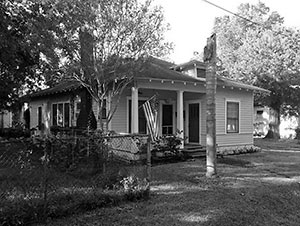HOW IT WAS BEFORE AIR CONDITIONING EVEN  A longtime Swamplot reader brings up the ‘H’ word: “I know Houston isn’t big on preserving many things, but I was wondering if you or your other readers knew of a good resource where I could possibly do some ‘historical’ research on my home? I must admit that I am jealous of homes on the East Coast that have a legacy of some sort. I am aware that something like this wouldn’t exist on my property, but I’d like to see if I could find older pictures of it and/or see how the area was like ‘back in the day.’ My home was built in 1923 according to HCAD, so there MUST be something out there . . . right?” Photo of 506 Cottage St., Brooke Smith: HAR
A longtime Swamplot reader brings up the ‘H’ word: “I know Houston isn’t big on preserving many things, but I was wondering if you or your other readers knew of a good resource where I could possibly do some ‘historical’ research on my home? I must admit that I am jealous of homes on the East Coast that have a legacy of some sort. I am aware that something like this wouldn’t exist on my property, but I’d like to see if I could find older pictures of it and/or see how the area was like ‘back in the day.’ My home was built in 1923 according to HCAD, so there MUST be something out there . . . right?” Photo of 506 Cottage St., Brooke Smith: HAR





If so let me know. My place was built in 1906. I’d love to know how it looked. For one reason, I’d love to build a balcony out of the top floor but I can’t unless I can “prove” that it was originally like that (historic subdivision rules)
My advice:
(1) Google your address (you never know);
(2) Go to the downtown public library, it’s a treasure trove; and
(3) ask long-time or elderly neighbors (if there are any left to ask).
Your house was built in 1923? My condolences to you and your family. But do not despair, I know things seem now like it can’t get any worse, and it probably cant, but one day with hard work and perseverance you will get out of the carcinogen and disease packed shelter of last resort and live in a actual house with modern plumbing and insulation. But do not wait too long, the current one can catch on fire and burn to the ground in mere minutes, due to that first growth wood, no fire blocking construction, and lack of sprinklers.
Harris County has a wealth of archives that you can seek out. Ed Emmett, in his last newsletter:
http://www.judgeemmett.org/Newsletters/Newsletter_Dec_2009.html
has a link to many of these. Our neighborhood association just got a list from Harris County in a PDF file. (I can upload this to Gus if he wants, and then he can post it somewhere convenient)
Start off by talking to the realtor on the linked page – Eugene Werlin (Sr.?) is a pretty big Houston architecture name
Commonsense gets my vote for best comment posted.
Check the Harris County Archives for photographs and other information. Also, though these photos won’t be as old, read about how the Old Sixth Ward got all the 1970s-era photos that are on its site from HCAD’s predecessor.
Whoops, County Archives link is here.
Hi, @Vonroach – Can these be accessed electronically, or do you have to go in person? Would you happen to know if the file that you have is featured in an older newsletter if Gus can’t upload it somewhere?
The Texas Room archives in the historic Julia Ideson Library downtown is the best place to start. They have old city directories that were like phone books with homes listed by address. They go back to about 1900 and list the name of the head of household and their occupation. Also there are aerial photographs taken of Houston every decade starting in 1925. They have incredible resolution and I use them all the time to get my projects approved with the Historic Commission.
Good luck finding exterior photos… some neighborhoods have special folders with photos, brochures, newspaper clippings, but it is random and unorganized. The best is to ask your neighbors. My neighbor across the street had photos of their children/grandchildren playing in their yard growing up decades ago and while the kids were the focus of the photos, my house is in the background of every one.
Other things to research are the Sanborn fire insurance maps showing the structures on the street and the 1940 Census is online now to see more details of who lived on the street and what their income was
http://www2.houstonlibrary.org/hmrc/txr.html
http://1940census.archives.gov/
Preservation Houston is also a good place to turn for things like this — part of what they do is helping property owners research their houses/buildings.
@Cory,
I assume you’re familiar with this:
http://www.westmorelandpreservationalliance.org/westmorelandhistory.html
Agree with Spencer, and will add that the City Directories are also on Ancestry.com (and likely other places, but we have a membership to that site). I’m fourth owner of a 1936 house, and I was able to find the son of the original owners through a little sleuthing. Regardless of what you find, it’s a fun process and you will find yourself lost in pictures for hours…even if they aren’t pictures of your house!
I would rebut Commonsense, but it’s not worth my time. I’ll just go on enjoying my old house.
Coconut Butter – Many of these records have not been digitized, so you will need to go to the various libraries.
Think of it as a fun and interesting field trip!
Become a detective and, over time, you’ll piece together a lot of the house’s history. I found the wife of the son of the original owner in Galveston looking on the internet. She was in her 80s but, after a few minutes, things started to come back to her little by little and she remembered lots from when she was a newlywed and lived with her inlaws in 1939 in the house. The Ideson Library as mentioned might add some info too. Also, I joined Ancestry.com and did a tree on the original owner’s family and, using census and other documents I was able to really get a full picture of who and how long the family and their children lived here.
You might try the Clayton library – they have a lot of old directories and census records as well. They are pretty helpful with genealogical research. http://www2.houstonlibrary.org/clayton/
The Clayton Library Center for Genealogical Research branch (located at 5300 Caroline, 77004) also has a set of Houston City Directories as well as other resources.
You could also go to the downtown central Houston Public Library and spend time with the microfiche/microfilm collections of local Houston newspapers: the Houston Chronicle, the Houston Post (which ended in 1995) and the original Houston Press (which ended in 1964). All of the newspapers had real estate sections that would often run articles on new residential developments as well as a focus on certain homes.
Unfortunately, the older Houston newspapers are NOT online — the Hearst Corp. (which owns the Chronicle and Post archives) is not interested in making them available online. I would love to be able to read old newspapers on my computer but Hearst Corp. thinks there’s no way to make money on digitizing old Houston newspaper archives.
lol, looks like the growing power of our historic preservation laws and the growing interest in history among Houstonians is making our usual trolls more desperate and nasty than the last time I was on Swamplot…
Good for you. I hope you are intrigued by the interesting data you will surely find in the above named resources.
@commonsense…you mean your home was built in 2010? My apologies for getting screwed. Not to worry..Enjoy the modern amenities while you stare at the cheaply built (pine), bland, cookie-cutter with no history or architectural significance of a house in disgust. But remember, pine burns faster than oak, my friend. “First Growth” wood is harder, and stronger, more resistant to rot and insects, and more stable. This makes a huge difference when talking about the quality of a home.